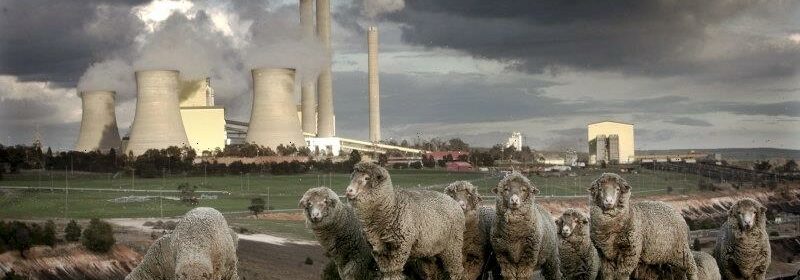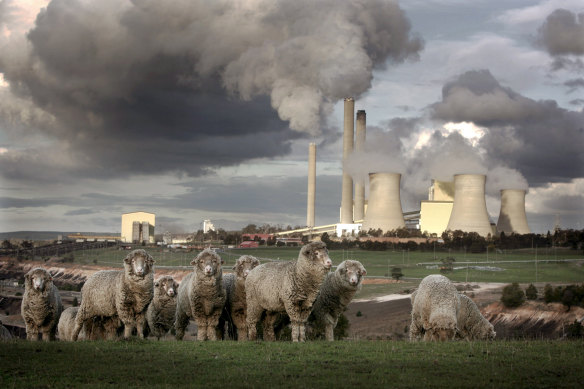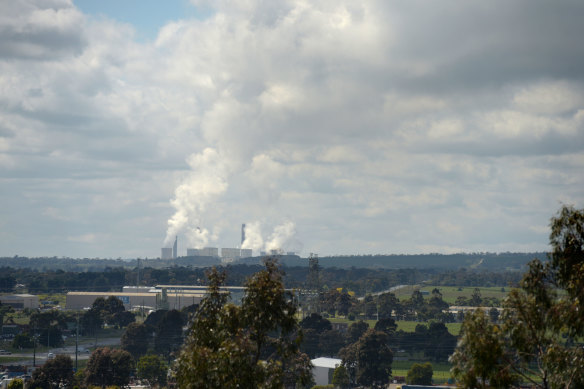Switch to state control starts clock ticking on coal-fired power plants

Victoria’s three remaining coal-fired power plants are likely to close years earlier than expected after the Andrews government announced a $1 billion plan to aggressively ramp up renewable energy and become an active competitor in the state’s electricity market.
Premier Daniel Andrews and Energy Minister Lily D’Ambrosio said on Thursday that a re-elected Labor government would revive the State Electricity Commission – which was carved-up and sold off in the 1990s – promising “unreliable, privatised coal will be replaced by clean, government-owned renewable energy”.
Alinta’s Loy Yang B coal power generator is officially due to close in 2047.Credit:Nine
“Those power stations won’t be for profit,” Andrews said. “It’s about building offshore wind, not building offshore profits.”
Under the plan, a re-elected Labor government would spend $1 billion to create 4.5 gigawatts of energy from wind and solar projects, enough to replace AGL’s ageing Loy Yang A coal-fired power plant.
But energy experts and private sector operators said it was now likely that the state’s three coal-fired plants would shut down years earlier than expected.
Energy Security Board chair Kerry Schott said: “I don’t know what it means for the owners of Loy Yang A, Loy Yang B and Yallourn.
“They’ve all got power plants that when they close need to be replaced with renewables, but this is probably going to bring forward their closure date. And when they close they are worth nothing but scrap.”
Andrews said his plan would cut power bills and create 59,000 jobs, but with the state’s century-old reliance on brown coal for electricity now likely to end sooner than expected, Victoria’s is also accelerating its emissions targets. The state is now aiming to cut emissions by 80 per cent compared to 2005 levels by 2035, and to net-zero by 2045 – five years earlier than planned.
Tony Wood, director of energy at the Grattan Institute, said more aggressive renewables policies had caused earlier coal closures in the past.
“We’ve already seen Loy Yang A’s closure being brought forward anyway, so that may not change again. But what we are going to see almost certainly now is Alinta, which owns Loy Yang B, bring forward that closure. I don’t see how it can stay open until 2035 anyway because otherwise you don’t achieve your renewable target.”
The public would own a 51 per cent stake in the various renewable energy projects run by the revived commission, with the balance of the investment from “like-minded entities” such as industry super funds. There is no suggestion in the plan that the government would take over private distribution or retail businesses.
AGL recently announced it would close Loy Yang A, the state’s largest power plant, a decade earlier, in 2035. Alinta’s Loy Yang B is officially due to close in 2047, while EnergyAustralia’s Yallourn is officially slated to close in mid-2028.
Andrews addressed concerns about Loy Yang B’s closure and said Alinta was already unlikely to keep the plant open until its scheduled closure date in 2047.
“They haven’t formally said that. They’re in the process of trying to sell their business at the moment, so I don’t know whether that’s part of the reason why they might not necessarily make that statement,” he said on ABC radio.
Alinta chief executive Jeff Dimery said the government’s move could cost jobs. “Our immediate priority and focus will be supporting our employees at Loy Yang B who will be understandably shocked by this announcement,” he said.
“We have one of the most well-advanced renewables and storage project pipelines, but we need to understand more about how the government intends to manage the cost of the expedited transition, protect communities and workers, and support us to invest in the replacement generation required to keep the lights on in the state,” he said in a statement.
Professor Bruce Mountain, from Victoria University, said while the announcement did not include any direct relief for consumers, it should drive down bills soon after the commission is established.
The government would reinvest profit in the generation of more power, adding supply and keeping costs down. Mountain said that was a “perfectly plausible” position.
“I don’t think that will take long [for the benefit to be passed onto consumers] … I’m loath to ever put a dollar and a time on these things.”
The minority investor would be expected to take a reasonable return, but not excessive profit paid out to shareholders.
“Too much of our electricity revenue has gone out in unnecessary profits, and I think ensuring that’s reinvested in cleaner technology can promise us a cheaper future,” Mountain said.
The Australian Energy Council, an industry body representing energy retailers and generators, said the plan would damage market and investor confidence.
Power stations in the Latrobe Valley are likely to close years earlier.Credit:Bloomberg
“Government shouldn’t need to make direct energy investments where the private sector has demonstrated it is ready and willing to do so,” chief executive Sarah McNamara said in a statement.
“Our members have announced billions of dollars of investments to support the Victorian and Australian energy transition. [Thursday’s] announcement will destabilise future investment plans.”
She rejected suggestions that privatisation had not served Victoria well, saying it helped the state recover from the 1990s recession.
Andrews said $20 million would be invested to prepare the revived commission and open an office in Morwell, in the Latrobe Valley, and he did not rule out the potential for a publicly owned retailer to be established at a later date.
The commission was previously a government-owned power supplier and distributor before it was privatised by the Kennett Liberal government in the 1990s, a decision Andrews said failed consumers and drove up power bills.
Queensland’s government owns generator, network and distribution electricity assets worth $35 billion. The federal government owns Snowy Hydro, which owns more than a dozen energy assets, including gas-fired stations in Victoria.
Renewable energy expert Tristan Edis, director of analysis at Green Energy Markets, said the state government deserved credit for its work transitioning to renewable energy, but he warned the public should not have a rose-coloured view of the old commission, which he said had left Victorian taxpayers exposed to significant costs.
Edis also questioned the government’s focus on offshore wind, which is relatively expensive to build and maintain compared to onshore wind. He said future technology could also favour rooftop solar coupled with household batteries, which would require less investment in poles and wires.
“We have got to keep this in perspective, Edis said. “It’s $1 billion of equity to go into a company, it will at best be one competitor. It’s not going to dominate the electricity system. But I’m just concerned that people’s nostalgia means they fail to appreciate the lessons of the past, which is not that the private sector gets it right all the time, it’s that when they screw up they pay the price.”
Tim Wilson, who was assistant minister for industry, energy and emissions reduction in the former Morrison government, said reviving the commission could lead to higher prices, lower reliability and a slower energy transition by crowding out private sector investment.
“Energy needs two things: the dynamism of innovation through new technologies, and a stable environment to encourage investment to increase supply and drive down prices,” he said.
“A State Electricity Commission will do the reverse and discourage new private investment and make decisions based on political considerations, not customers.”
Opposition education spokesman David Hodgett said the Coalition would have more to say in coming weeks.
“We have a plan for reliable, affordable, clean energy and we’ll certainly have more to say about that in coming weeks,” Hodgett said.
The state opposition has previously committed to halving emissions by 2030 and funding a $1 billion strategy to support clean hydrogen.
Labor’s announcement was welcomed for its cost-saving measures, for giving workers a transition into new work and for driving down emissions by the Victorian Trades Hall, Electrical Trades Union, Salvation Army, Victorian Council of Social Services, Environment Victoria and the Climate Council.
Dr Jennifer Rayner, head of advocacy at the Climate Council, said she hoped Victoria starts a “race to the top from Australian states and territories”.
Victorian Chamber of Industry and Commerce chief executive Paul Guerra said the intent of Thursday’s announcement was admirable, but more detail was needed to understand how businesses might be impacted.
Australian Industry Group’s Victorian head, Tim Piper, said he was sceptical about the revival of the commission. He said the original version was disbanded because it became too costly, and said the current government would be “walking a fine line” running an energy operator at the same time as maintaining private investment.
On the renewable target, Piper pointed out that, by 2035, only about 5 per cent of Victorian power would be generated by gas.
“How can that transformation have occurred so quickly and what does it mean for those who use gas?” he said.
The Morning Edition newsletter is our guide to the day’s most important and interesting stories, analysis and insights. Sign up here.
Most Viewed in Politics
From our partners
Source: Read Full Article

